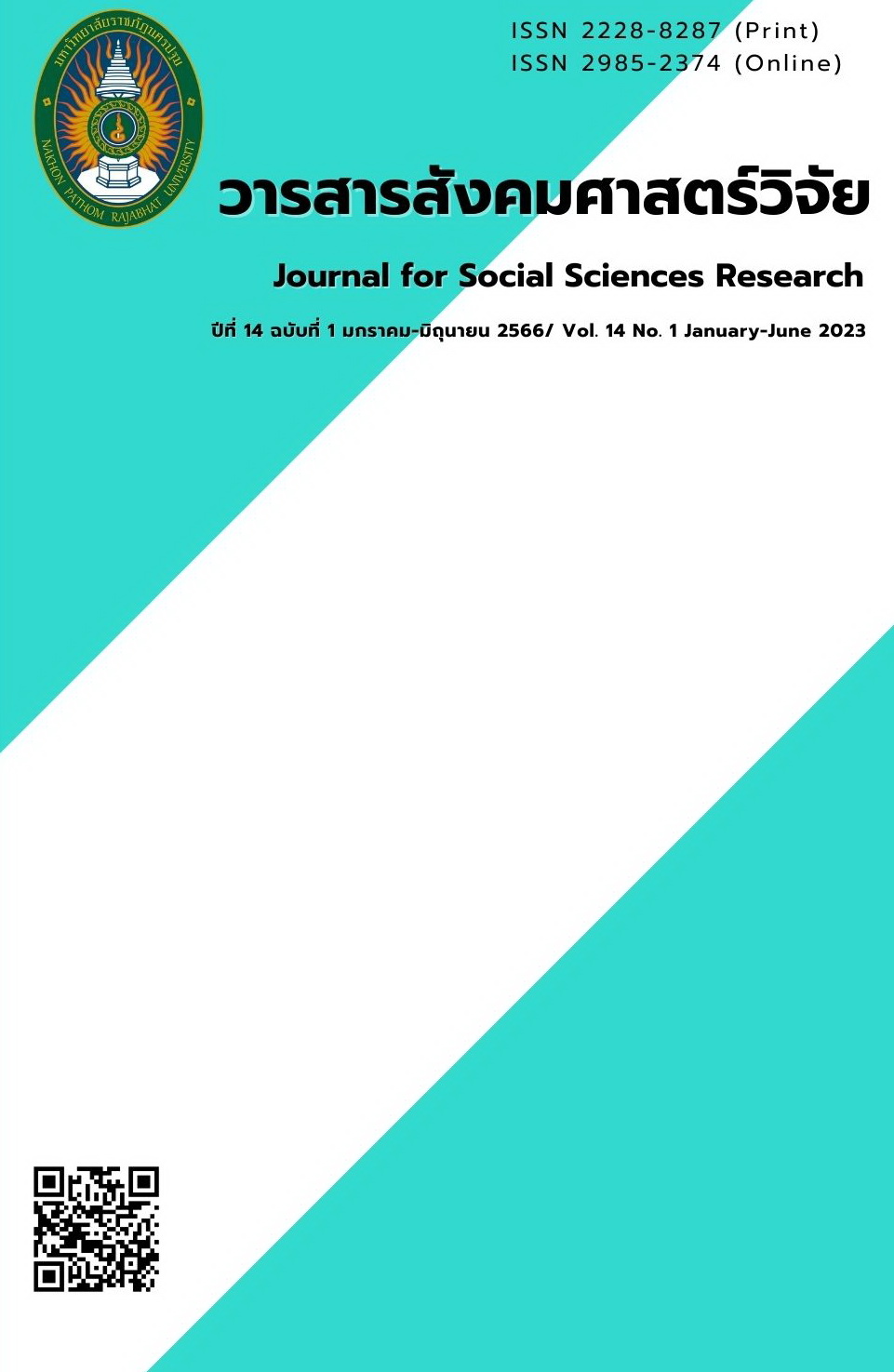CAUSAL FACTORS AFFECTING LEARNING AND INNOVATION SKILLS IN THE 21ST CENTURY OF SECONDARY SCHOOL STUDENTS IN LOPBURI PROVINCE
Main Article Content
Abstract
This research aimed to: 1) study the causal factors affecting learning and innovation skills in the 21st century of secondary school students in Lopburi Province; and 2) study the guidelines for promoting learning skills and innovation in the 21st century of secondary school students in Lopburi Province. The sample consisted of 432 students in schools under the Lop Buri Secondary Educational Service Area Office 5, in the academic year 2021, derived by cluster random sampling and there were 5 key informants, derived by purposive selection. The research instruments were a questionnaire and an interview form. Data were analyzed using descriptive statistics and CB-SEM structural equation model analysis; and qualitative data were analyzed using content analysis
The results showed that 1) causal factors affecting learning and innovation skills in the 21st century of secondary school students in Lopburi Province were: 1.1) Learning management, using learning management model appropriate to and in line with learners’ needs. 1.2) Learning environment, providing positive classroom atmosphere in physical aspect and promoting learning atmosphere that meets learning objectives. 1.3) Achievement motivation, using primary needs of learners in conjunction with reasoning and analytical thinking for further development. 2) The guidelines for promoting learning skills and innovation in the 21st century of secondary school students in Lopburi Province were: 2.1) in achievement motivation aspect, promoting and supporting learners to gain interest and awareness; 2.2) in learning environment aspect, promoting and supporting the teaching and learning atmosphere that meets the learning objectives; 2.3) in teacher’s learning management, developing teachers to be able to manage learning according to their competence and have the ability to use technology appropriately. This research suggests that other supporting factors that affect learning and innovation skills should be studied, e.g., attitudes, learning curriculum, learning values, and educational standards.
Article Details

This work is licensed under a Creative Commons Attribution-NonCommercial-NoDerivatives 4.0 International License.
บทความที่ได้รับการตีพิมพ์เป็นลิขสิทธิ์ของมหาวิทยาลัยราชภัฏนครปฐม
เนื้อหาของแต่ละบทความเป็นทัศนะของผู้เขียน ซึ่งที่ปรึกษา บรรณาธิการ กองบรรณาธิการ และคณะกรรมการบริหารวารสารไม่จำเป็นต้องเห็นด้วย หรือร่วมรับผิดชอบใดๆ
References
จันทร์เพ็ญ อามพัฒน์ และคณะ. (2561). ปัจจัยสัมพันธ์กับการรับรู้สู่ทักษะการเรียนรู้ในศตวรรษที่ 21 ของนักศึกษาพยาบาล วิทยาลัยพยาบาลพระปกเกล้า. วารสารวิทยาลัยพยาบาลพระปกเกล้าจันทบุรี, 29 (2), 36-46.
จินตนา ศิริธัญญารัตน์ และวิสาข์ จัติวัตร์. (2558). พยายามยัดเยียดวิทยาการดาวเทียมที่เก่งมาก กลยุทธ์การเรียนรู้เพื่อส่งเสริมการเชื่อกลยุทธ์ 21 และจิตวิทยาศาสตร์ของนักเรียนชั้นศึกษา. วารสารศิลปากรศึกษาวิจัย, 7 (1), 148-162.
เจษฎาภรณ์ อ้นแก้ว, พัชราวลัย มีทรัพย์ และนิคม นาคอ้าย. (2557). ปัจจัยที่มีอิทธิพลต่อผลสัมฤทธิ์ทางการเรียนกลุ่มสาระการเรียนรู้วิทยาศาสตร์ของนักเรียนชั้นประถมศึกษาปีที่ 6 ในโรงเรียนสังกัดสำนักงานเขตพื้นที่การศึกษาประถมศึกษาจังหวัดพิษณุโลก. Humanities and Social Sciences Journal of Pibulsongkram Rajabhat University, 8 (1), 18-36.
ฉันทนา วุฒิศิริพรรณ. (2557). ปัจจัยเชิงสาเหตุที่มีผลต่อทักษะชีวิตของนักเรียนระดับชั้นมัธยมศึกษาปีที่ 3 สำนักงานเขตพื้นที่การศึกษามัธยมศึกษา เขต 2. วารสารครุศาสตร์อุตสาหกรรม สถาบันเทคโนโลยีพระจอมเกล้าคุณทหารลาดกระบัง, 14 (2), 471-478.
ชยาภรณ์ คําตุ้ย. (2560). ปัจจัยเชิงสาเหตุที่ส่งผลต่อทักษะชีวิตและงานอาชีพในศตวรรษที่ 21 ของนักเรียนกลุ่มชาติพันธุ์ ชั้นประถมศึกษาปีที่ 6 สังกัดสำนักงานเขตพื้นที่การศึกษาประถมศึกษาเชียงราย เขต 3. วารสารการวิจัยกาสะลองคํา มหาวิทยาลัยราชภัฏเชียงราย, 11 (2), 25-33.
นพพร จันทรนำชู และทิพย์วรรณ สุขใจรุ่งวัฒนา. (2561). รายงานการวิจัย แนวทางการพัฒนาทักษะวิชาชีพของนักศึกษาสถาบันการอาชีวศึกษาภาคกลาง 4 เพื่อการพัฒนาทรัพยากรมนุษย์สู่ประเทศไทย 4.0. นครปฐม: มหาวิทยาลัยศิลปากร.
นพพร จันทรนำชู และวสวัตติ์ วงศ์พันธุเศรษฐ์. (2565). ตัวแบบความสัมพันธ์เชิงสาเหตุที่ส่งผลต่อทักษะการเรียนรู้และนวัตกรรมของนักเรียนโรงเรียนสาธิต ระดับมัธยมศึกษา จังหวัดนครปฐม. วารสารมนุษยศาสตร์และสังคมศาสตร์ มหาวิทยาลัยนครพนม, 13 (1), 116-129.
ปรียา พงศาปาน และคณะ. (2560). ปัจจัยเชิงสาเหตุที่ส่งผลต่อทักษะการเรียนรู้และนวัตกรรมในศตวรรษที่ 21 ของนักเรียนชั้นมัธยมศึกษาปีที่ 2 สังกัดสำนักงานเขตพื้นที่การศึกษาประถมศึกษาเชียงราย เขต 3. วารสารการวิจัยกาสะลองคำ มหาวิทยาลัยราชภัฏเชียงราย, 12 (1), 21-30.
พิกุล เอกวรางกูร, ชานนท์ จันทรา และกรกฎา นักคิ้ม. (2561). แนวทางการส่งเสริมพฤติกรรมการสอนของครูการศึกษาขั้นพื้นฐานที่ส่งผลต่อการพัฒนาผลสัมฤทธิ์ทางการเรียน. วารสารวิทยาลัยดุสิตธานี, 12 (3), 367-381.
พิมพาพัญ ทองกิ่ง. (2563). บทบาทครูกับการจัดบรรยากาศชั้นเรียนเชิงบวกในศตวรรษที่ 21. ศึกษาศาสตร์สาร มหาวิทยาลัยเชียงใหม่, 4 (1), 50-59.
สำนักงานเขตพื้นที่การศึกษามัธยมศึกษา เขต 5. (2563). ข้อมูลโรงเรียน. ค้นเมื่อ 20 มิถุนายน 2564, จาก http://secondary5.go.th/th/
สุดเฉลิม ศัสตราพฤกษ์. (2560). การจัดการเรียนการสอนในศตวรรษที่ 21 แบบห้องเรียนกลับด้านเพื่อการพัฒนาทักษะการเรียนรู้และนวัตกรรม. วารสารวิทยบริการมหาวิทยาลัยสงขลานครินทร์, 28 (1), 100-108.
อรอนงค์ แสนคำ. (2561). รูปแบบความสัมพันธ์เชิงสาเหตุของปัจจัยที่ส่งผลต่อทักษะชีวิตนักเรียนในโรงเรียน สังกัดสำนักงานเขตพื้นที่การศึกษาประถมศึกษา ในภาคตะวันออกเฉียงเหนือ. วารสารมหาวิทยาลัยนครพนม, 8 (2), 72-80.
Beck, R. C. (2004). Motivation: Theories and principles (15th ed.). New Jersey: Pearson Education.
Comrey, A. L. & Lee, H. B. (2013). A first course in factor analysis (2nd ed.). New York: Psychology Press, Hove.
Franken, R. E. (2007). Human motivation (6th ed.). California: Thomson Wadsworth.
Gallucci, M. & Jentschke, S. (2022). SEM 0.3.0 by Marcello. Retrieved 13 May 2022, from https://github.com/semlj/semlj
Great School Partnership. (2013). Learning management. Retrieved 8 May 2022, from shorturl.at/pCFG8
Hair, J. F., Black, W. C., Babin, B. J. & Anderson, R. E. (2017). Multivariate data analysis (8th ed.). New York: Pearson.
Hooper, D., Coughlan, J. & Mullen, M. (2008). Structural equation modelling: Guidelines for determining model fit. Electronic Journal of Business Research Methods, 6 (1), 53-60.
Klien, J. A. (2001). Coaching skill for managers and supervisors. Retrieved 18 August 2011, from http://www.amazon.com
Köksal, P. O., Yagisan, N. & Cekic, A. (2013). The effects of music on achievement, attitude and retention in primary school English lessons. Procedia-Social and Behavioral Sciences, 2013 (93), 1897-1900.
Schreiber, J., Nora, A., Stage, F. K. & Barlow, E. A. (2006). Reporting structural equation modeling and confirmatory factor analysis results: A review. The Journal of Educational Research, 99 (6), 323-338.
Smith, R. & Lynch, S. (2010). Rethinking teacher education: Teacher education in the knowledge age. Sydney: AACLM Press.
Tabachnick, B. G. & Fidell, L. S. (2013). Using multivariate statistics (6th ed.). New York: Pearson Education.
The Jamovi Project. (2021). Jamovi (Version 1.6) [Computer Software]. Retrieved 24 June 2022, from https://www.jamovi.org
The Partnership for 21st Century Learning. (2017). Framework for 21st Century Learning. Retrieved 2 April 2022, from http://www.p21.org/our-work/p21-framework


